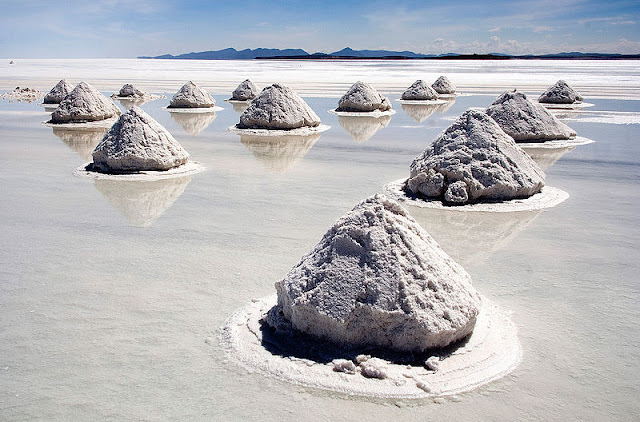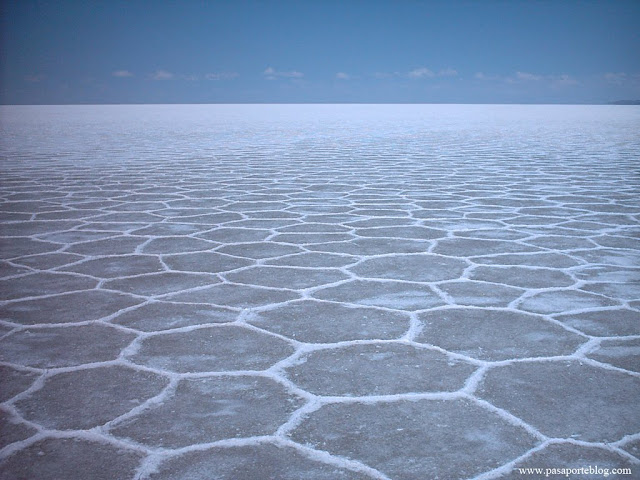See also : Landscape with ice
Salar De Uyuni, Bolivia
Salar de Uyuni (or Salar de Tunupa) is the world's largest salt flat at 10,582 km² (4,085 square miles). It is located in the Potosí and Oruro departments in southwest Bolivia, near the crest of the Andes, 3,650 meters high. The major minerals in the salar are halite and gypsum. [Wikipedia]
Photo Credit: pasaporteblog.com
Kauai, Hawaii
Kauaʻi or Kauai is the oldest of the main Hawaiian Islands. With an area of 552.3 square miles (1,430.5 km2), it is the fourth largest of the main islands in the Hawaiian archipelago and the 21st largest island in the United States. Known also as the "Garden Isle", Kauaʻi lies 105 miles (170 kilometers) across the Kauaʻi Channel, northwest of Oʻahu.
Kauai - Photo credit: Patrick Smith Photography
Black and White desert, Egypt
Black and White desert - Photo Credit: matadornetwork.cachefly.net
The Wave, Arizona, US
The Wave is a sandstone rock formation located in the United States of America near the Arizona and Utah border on the slopes of the Coyote Buttes, in the Paria Canyon-Vermilion Cliffs Wilderness, on the Colorado Plateau. It is famous among hikers and photographers for its colorful, undulating forms, and the rugged, trackless hike required to reach it.
The Wave - Photo Credit: Wikipedia
Chocolate Hills, Bohol, Philipines
he Chocolate Hills are an unusual geological formation in Bohol, Philippines. According to the latest accurate survey done,[citation needed] there are 1,776 hills spread over an area of more than 50 square kilometres (20 sq mi). They are covered in green grass that turns brown during the dry season, hence the name.
Chocolate Hills - Photo Credit: Wikipedia
Black Rock Desert, Nevada, US
The Black Rock Desert is a dry lake bed and the surrounding endorheic basin in northwestern Nevada in the United States. The flat expanse of dry lake, or playa, is a remnant of the prehistoric Lake Lahontan, which existed between 18,000 and 7,000 BC during the last ice age. During the lake's peak around 12,700 years ago, the desert floor was under approximately 500 ft (150 m) of water.
Black Rock Desert - Photo Credit: National Geographic
Cappadocia, Turkey
Cappadocia is a region in central Turkey, largely in Nevşehir Province .
Cappadocia - Photo Credit: Wikipedia
Monument Valley, Arizona, US
Monument Valley is a region of the Colorado Plateau characterized by a cluster of vast and iconic sandstone buttes, the largest reaching 1,000 ft (300 m) above the valley floor. It is located on the southern border of Utah with northern Arizona (around 36°59′N 110°6′W), near the Four Corners area. The valley lies within the range of the Navajo Nation Reservation, and is accessible from U.S. Highway 163.
Monument Valley - Photo Credit: pdphoto.org
Clay Formations in Dunes, Death Valley

Clay Formations in Dunes - Source
Devils Cornfield, Death Valley

Devils Cornfield - Photo Credit: nationalgeographic.com
Devil's Golf Course, Death Valley National Park, US
The knarled terrain of an ancient evaporated lake contains crystals of almost pure table salt. The craggy lake bottom is complex and intricate with crystals in various stages of development. Deposited by ancient salt lakes and shaped by winds and rain, the crystals are forever changing. The Death Valley saltpan is one of the largest saltpans in North America. Salt continues to be deposited by recurring floods that occasionally submerge the lowest parts of the valley floor.
Socotra Island, Yemen
Socotra Island, a small 4-island archipelago in the Indian Ocean, with a total area of 3,796 sq km, located around 190 miles south of the Arabian peninsula. It belongs to the Republic of Yemen. This island hosts a few hundred species of plants and animals which cannot be found anywhere else on Earth. It is a real life 'Alice in the Wonderland'.
Socotra Island trees - Photo Credit: karmapanda.com
Vale Da Lua - Moon Valley, Brazil
The Vale da Lua, or Moon Valley is a place that will literally make you feel like you are on another planet, while walking around you may literally feel like an alien is gonna appear. These rock formations were caused by water erosion over many years and along with the terrestrial landscape there are also natural pools throughout. The rock formations seen are mostly quartz and crystaland they are among some of the oldest on Earth.
Vale Da Lua - Photo credit: pbase.com
The Great Blue Hole, Belize
The Great Blue Hole is a large underwater sinkhole off the coast of Belize. It lies near the center of Lighthouse Reef, a small atoll 100 kilometres (62 mi) from the mainland and Belize City. The hole is circular in shape, over 300 metres (984 ft) across and 125 metres (410 ft) deep. It was formed as a limestone cave system during the last glacial period when sea levels were much lower. As the ocean began to rise again, the caves flooded, and the roof collapsed. Believed to be the world’s largest feature of its kind, the Great Blue Hole is part of the larger Belize Barrier Reef Reserve System, a World Heritage site of the United Nations Educational, Scientific and Cultural Organization (UNESCO).
The Great Blue Hole - Photo Credit: National Geographic
Ice Circle
An ice circle is a rare phenomenon that occurs in slow moving water in cold climates. It consists of large discs of ice that rotate slowly in the water. It is believed that they form in eddy currents. Ice circles have most frequently been observed in Scandinavia and North America, but one was recorded in Britain in January 2009.
Arctic Ice Circle - Photo Credit: nationalgeographic.com
Ice Circle - Photo credit: irintech.com
Columnar Basalt
Basalt is a common extrusive volcanic rock. It is usually grey to black and fine-grained due to rapid cooling of lava at the surface of a planet. It may be porphyritic containing larger crystals in a fine matrix, or vesicular, or frothy scoria. Unweathered basalt is black or grey.
Panska Skala - Photo credit: Wikipedia
Giant's Causeway in Northern Ireland
Penitentes
Penitentes are a snow formation found at high altitudes. They take the form of tall thin blades of hardened snow or ice closely spaced with the blades oriented towards the general direction of the sun. Penitentes can be as tall as a person.
Penitentes on Mount Rainier - Photo credit: www.ii.uib.no
Cave of the crystal, Mexico
The Naica Mine of Chihuahua, Mexico, is a working mine that is known for its extraordinary crystals. Naica is a lead, zinc and silver mine in which large voids have been found, containing crystals of selenite (gypsum) as large as 4 feet in diameter and 50 feet long. The chamber holding these crystals is known as the Crystal Cave of Giants, and is approximately 1000 feet down in the limestone host rock of the mine. The crystals were formed by hydrothermal fluids emanating from the magma chambers below. The cavern was discovered while the miners were drilling through the Naica fault, which they were worried would flood the mine. The Cave of Swords is another chamber in the Naica Mine, containing similar large crystals.
Cave of the crystal, Mexico - Photo credit: nationalgeographic.com
Moeraki Boulders, New Zealand
The Moeraki Boulders are huge spherical stones that are scattered over the sandy beaches, but they are not like ordinary round boulders that have been shaped by rivers and pounding seas. These boulders are classed as septarian concretions, and were formed in ancient sea floor sediments. They were created by a process similar to the formation of oyster pearls, where layers of material cover a central nucleus or core.
Moeraki Boulders - Photo credit: legrisak
Sun Dog
A sun dog or sundog (scientific name parhelion, plural parhelia, for "beside the sun". Also called a mock sun.) is a particular type of ice halo. It is a colored patch of light to the left or right of the sun, 22 (or more) degrees distant and at the same distance above the horizon as the sun. It is the most commonly or second most commonly seen of the ice halos. Sundogs can be seen anywhere in the world during any season. In Europe or USA they might be seen 1-2 times a week but not always obviously bright. They are best seen and at their most conspicuous when the sun is low. They are not rainbows.
Sun Dog - Photo credit: pbs.org
Really nice for travel purpose, happy travelling .......
Categories:
Photo































6 comments:
Hi, thanks for choosing one of our pictures, your could see moro photos of Salar de Uyuni on our travel blog Pasaporteblog.com
Salarde Uyuni, Bolivia
You should add "Pamukkale" in this list. It's also one of the most unique and astonishing places on earth
what about this one?
http://www.biosferabrasil.com/img/lencois5.jpg
hey
ahh i love the crystal cave
yes Pamukkale is amazingly beautiful
Post a Comment